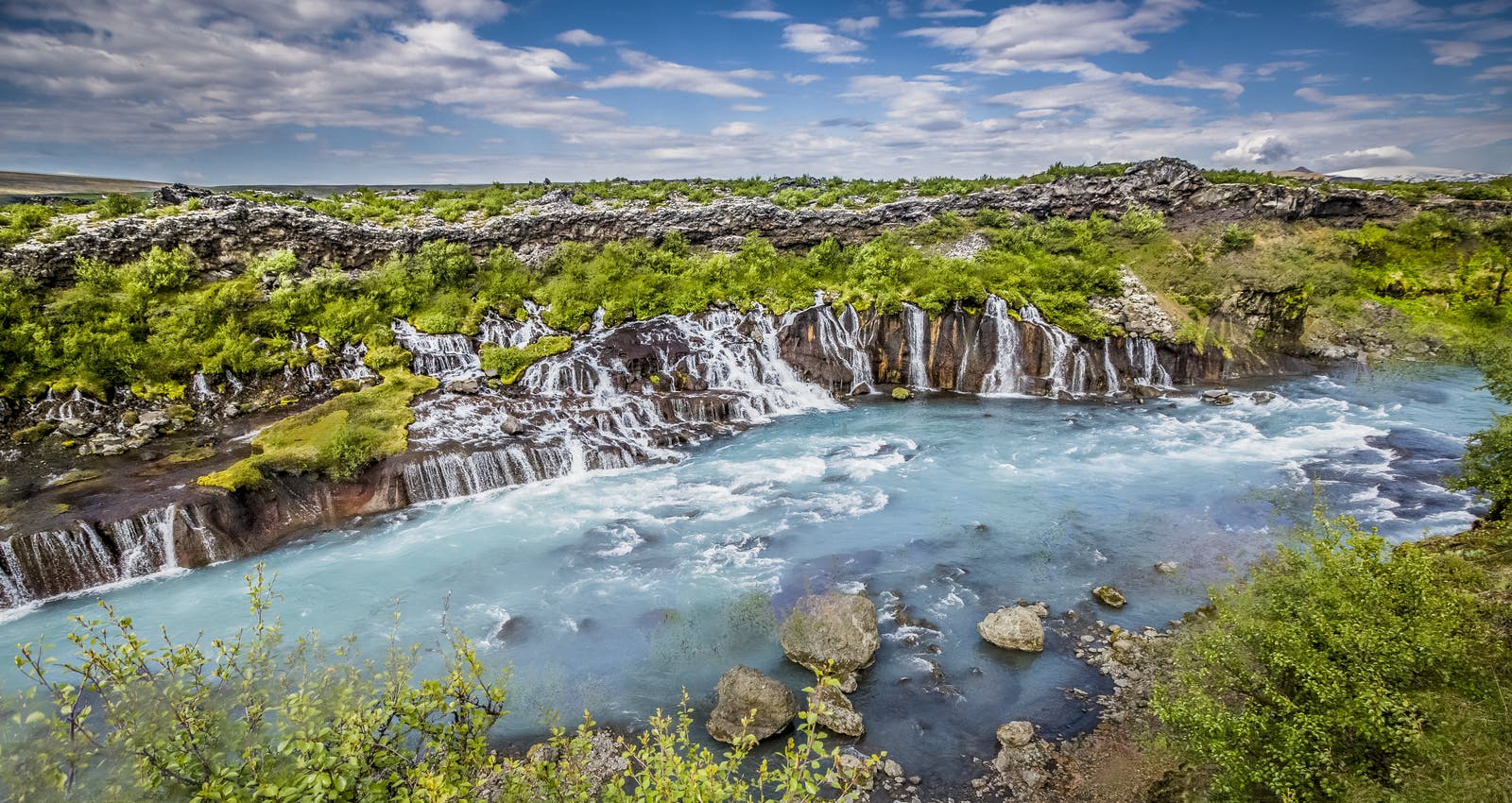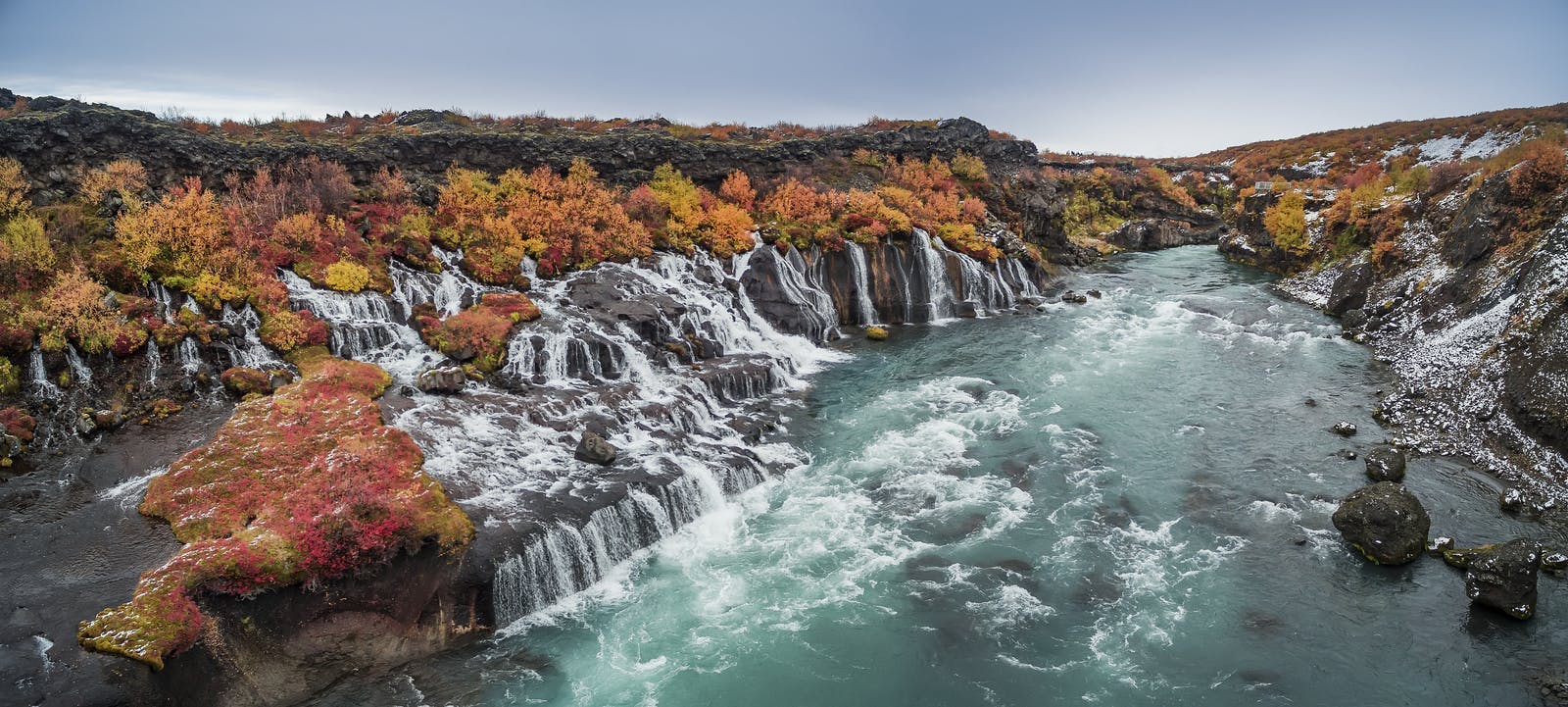
Hraunfossar: Iceland's Lava Waterfalls
In the western part of Iceland, where the earth's pulse is felt in every rock and river, lies the enchanting wonder of Hraunfossar. Hraunfossar, which translates to "Lava Falls" in Icelandic, derives its name from the unique way in which the water appears to emerge from the porous lava fields rather than from a traditional river or glacier source. This distinctive feature sets it apart from many other waterfalls around the world.
The water that forms Hraunfossar comes from underground springs or groundwater streams. These underground rivulets weave through the ancient lava fields, eventually surfacing at Hraunfossar, creating a stunning display of numerous small waterfalls cascading into the Hvítá River that collectively contribute to the site's overall charm.
Unlike powerful and thunderous waterfalls, Hraunfossar presents a more delicate and intricate cascade. The water flows gently over the lava rock, creating a series of thin streams that resemble a natural lace curtain. This unique and ethereal quality adds to the visual appeal of Hraunfossar.
Geological Significance

The lava fields surrounding Hraunfossar are part of extensive volcanic systems in Iceland. The falls themselves are a result of the Hallmundarhraun lava flow, which originated from an eruption that took place in the highland close to Langjökull glacier. The site is a living testament to the geological forces that have shaped Iceland over centuries.
Hallmundarhraun
Hallmundarhraun was formed by a volcanic eruption that occurred approximately a thousand years ago, in the 10th century, when Iceland was newly found and settled. While Hallmundarhraun itself is not typically visited for extensive exploration due to its rugged and barren nature, the surrounding area offers various points of interest. Visitors often explore nearby attractions, including Hraunfossar and Barnafoss waterfalls, the Deildartunguhver hot spring, and the Grábrók volcano.
Geology of Hraunfossar Waterfall

Hraunfossar is a unique and relatively wide cascade of waterfalls rather than a single, towering waterfall. The water in the falls is known for its bright turquoise colours.
Width: Hraunfossar spans a significant width, with numerous springs and streams extending across the lava field. The total width can vary, but it is generally considered to be over 400 metres (about 1,200 feet).
Height: The individual streams at Hraunfossar are relatively modest in height. The falls themselves are characterised by a gentle descent over the lava rock, and the drop for each stream is typically in the range of 0.5 to 3 metres (1.5 to 10 feet). The collective effect of the many streams flowing side by side creates a captivating and picturesque scene.
It is important to note that the beauty of Hraunfossar lies not in towering heights but in the unique and wide distribution of water over the lava field, giving it a distinctive and enchanting character. The falls are known for their delicate, lace-like appearance as the water seems to emerge directly from the porous lava, making it a one-of-a-kind natural wonder in Iceland.
Nearby Attractions
The wonders of this region do not end with Hraunfossar. Just a stone's throw away lies Barnafoss, a waterfall that adds a touch of drama to the otherwise serene landscape. Also, venturing further into the vicinity of Hraunfossar, you will discover Víðgelmir, one of Iceland's largest and most captivating lava caves.
Barnafoss

Barnafoss, known as "Children's Falls" in Icelandic, is a captivating waterfall in western Iceland, only about 200 m from the Hraunfossar cascades. Unlike its nearby counterpart's gentle elegance, Barnafoss tells a tragic tale etched into local folklore. Legend has it that two children from the nearby Húsafell farm met their untimely demise while attempting to cross a natural stone arch that once spanned the river. In mourning, their grief-stricken mother cursed the bridge, leading to its collapse and the creation of Barnafoss in its turbulent and powerful form.
The falls are characterised by their dramatic descent through a narrow canyon, with dark basalt columns framing the rushing waters. The tumultuous energy of Barnafoss stands in stark contrast to the delicate lace-like beauty of Hraunfossar. Visitors can witness the raw power of the falls, appreciating both the natural spectacle and the melancholic legend that has shaped the waterfall's mystique. Barnafoss, with its turbulent history and striking appearance, invites contemplation on the intersection of nature and myth in the rich tapestry of Icelandic landscapes.
Víðgelmir Cave

Víðgelmir is a portal to the underground world that lies beneath the country's surface, revealing the hidden wonders of Iceland's volcanic history. As you descend into the cave's depths, marvel at the intricate ice formations and colossal stalactites that adorn its walls, a testament to the slow dance between fire and ice that has shaped this land for centuries.
Víðgelmir is not just a geological spectacle; it is a living museum of sorts, preserving the secrets of Iceland's volcanic past. The cave's vast chambers and winding passages invite exploration, providing a glimpse into the powerful forces that have shaped the country's landscape. Guided tours offer a safe yet thrilling adventure, allowing visitors to navigate the labyrinthine beauty of Víðgelmir while learning about the geological processes that birthed such remarkable formations.
The Power Of Natural Forces
If you want to learn more about Icelandic nature, make sure to pay a visit to the Perlan Museum in Reykjavík. Here, you can dive deeper into subjects such as caves, volcanoes and waterfalls - all components of Hraunfossar. With a variety of exhibitions, Perlan offers an entertaining experience while exploring the fascinating power of Mother Earth.
How To Get to Hraunfossar From Reykjavík
Hraunfossar is located about 126 kilometres north of Reykjavík - a trip that usually takes about 2 hours by car. If you are keen on visiting Hraunfossar, here is a brief step-by-step guide to help you:
- Take Route 1, also known as the Ring Road, heading north from Reykjavik. After approximately 100 kilometres (62 miles), take a left turn onto Road 50 (also known as Víðidalur).
- Continue on Road 50: Follow Road 50 for about 63 kilometres (39 miles) until you reach the junction with Road 518. Take a left onto Road 518.
- Arrival at Hraunfossar: After about 10 kilometres (6 miles) on Road 518, you will arrive at Hraunfossar. Signs and parking areas will guide you to the viewing points for the waterfalls.
Hraunfossar FAQ
How To Get to Hraunfossar?
You can get to Hraunfossar by car or by joining one of many tour operators on their pre-arranged trips.
What Does Hraunfossar Mean?
Hraunfossar directly translates to 'Lava Waterfalls'.
How Long Is The Hike to Hraunfossar?
There is no extensive hike required to reach the falls. Upon arriving at the parking areas nearby, it is a short and straightforward walk to the viewing points.







